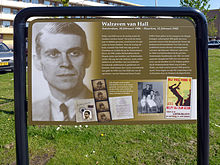Walraven van Hall
| Walraven van Hall | |
|---|---|

Memorial at Gouda
|
|
| Born |
10 February 1906 Amsterdam |
| Died | 12 February 1945 (aged 39) Haarlem |
| Nationality | Dutch |
| Other names | "de Olieman", Van Tuyl, Barends and "oom Piet" |
| Occupation | Banker |
Walraven (Wally) van Hall (10 February 1906 – 12 February 1945) was a Dutch banker and resistance leader during the occupation of the Netherlands in World War II.
Born into an influential Dutch family, van Hall initially studied to become an officer in the merchant marine, but after having worked for some years as third mate he was rejected because of his eyesight. Unable to work in the merchant marine, he moved to New York City in 1929. His brother, future mayor of Amsterdam Gijs van Hall, who already worked at a bank, helped him get a job with a Wall Street firm. Having thus been introduced to banking, he returned to the Netherlands and became a banker and stockbroker.
After the Germans invaded the Netherlands in May 1940, a fund was established to help families of merchant-sailors (who were stranded abroad when war broke out). Van Hall was asked to help set up the Amsterdam chapter together with his brother Gijs. Because of his banking experience, he was able to provide funding with the help of guarantees by the Dutch government in London. Soon the Germans began taking anti-Jewish and forced labour measures and resistance against these measures increased. Van Hall expanded his fund-raising activities for all kinds of resistance groups and he became known as the banker of the resistance.
One of the ways in which van Hall raised funds for the resistance was the "robbing" of the De Nederlandsche Bank (Dutch National Bank). With the approval of the Dutch government-in-exile, the van Halls managed to obtain as much as 50 million Dutch guilders. According to Nout Wellink, president of the bank in 2010, this figure is comparable to half a billion Euros nowadays. Together with his brother, van Hall falsified banknotes and changed them in the bank for the real notes. With these, paper money was collected. This was done behind the back of Rost van Tonningen, president of the bank and a notorious member of the Dutch Nazi party National Socialist Movement in the Netherlands (NSB).
Another way of collecting money was borrowing from wealthy Dutch people. As a proof of their investments, they got a worthless old stock, but after the war they could get their money back in exchange for the stock paper.
...
Wikipedia
